| Kids needs the right toys, just as adults need the proper tools to complete our tasks correctly. The "right" toys are not necessarily expensive, and children do not need very many of them. In fact, many of your child's favorite activities may not involve any "traditional" toys at all. Interacting with magazines that contain pictures, mirrors, plastic cups, yarn, water, cardboard boxes or simply playing make believe and singing a song can be great fun! Some excellent toys that are fairly inexpensive are building blocks and books. These types of toys usually appeal to a large variety of children and can be used over and over again for several years saving you money, don't forget Library books are FREE! Watch the way your child interacts with these toys at different stages in their lives! (Gee wiz they grow so fast!) Other awesome activities for kids are Arts and Crafts projects. Although many of these items will have to be repurchased over again they are still great investments and can result in hours of fun and learning. Be sure to check out simple stacking toys and puzzles to really challenge your little ones Needs help selecting the "right" toys for your tots? Check out our Toy buying checklist |
|
0 Comments
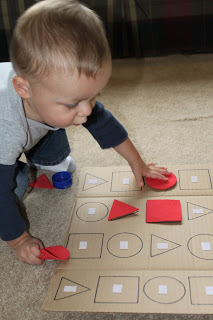 Got a toddler with lots of energy? Get him searching and matching. This is a great idea for indoors or outdoors. Just cut out shapes and then trace them on a cardboard cutout. Put velcro on both sides and let the fun begin!! You can hide the shapes around the room and they have to find them and match them up. You can also put all the shapes into a bucket and have them go to the bucket and back in different ways, such as jumping, crawling, on their knees, etc. 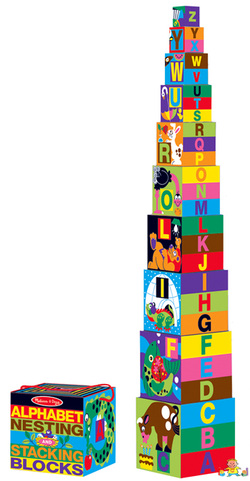 Patience needs practice. So does listening and following directions. Not all of us have mastered the technique of patience and following directions, but kids in general need extra practice in this area. Here is a fun way to work on these skills at home. Stack some blocks or cardboard boxes and have your kids stand in font of them. You say 'wait for it...' a couple of times before yelling "GO" and allowing them to knock them over with ninja kicks and power punches. Their anxiousness to knock them down will build up as you play and this makes a perfect setting for learning self-control and listening-skills. If they knock the cubes over before being told "GO" the game is over. 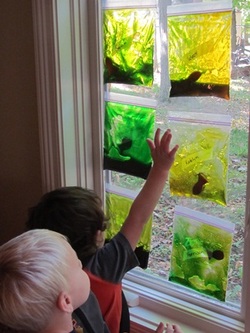 Best pet ever? I think so... Need a fun indoor activity to do with the kids at home? How about making a gel aquarium? It's great sensory fun and you can make a themed afternoon out of it, by reading a book centered around a fish, maybe cooking some fish at night for dinner or making fish-shaped cookies. Here's how to make it: Fill a zip-lock bag with hairgel and some food coloring, then add a gummybear fish. Add a few to make it more fun. Name your fish and maybe create a story around them!! You can tape them up to the window to see how they reflect the light. 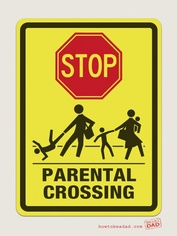 It's important to be able to differentiate between your child having a meltdown and a tantrum. This will make avoiding them as well as dealing with them easier. Lets begin with understanding what each one means. When your child is having a meltdown there is something out of their hands going on. A meltdown encompasses a physical, mental, or sensory element. Common causes of meltdowns include: hunger, lack of sleep, illness, sensory-overload, lack of energy-outlet. This is often avoidable and should not be reprimanded in the same manner as a tantrum. A tantrum, on the other hand, is simply behavioral. It's a communication tool that your child is using to get a message across and should not be encouraged. Here is a simple checklist you can use to help you differentiate which is occurring.
Because meltdowns are caused by something external, they should not be reprimanded like a tantrum. One must understand that the child is incapable of controlling their emotions, to a certain extent, because of something occurring TO them. These can be avoided by thinking ahead and being aware of your child's needs, schedules, habits, and states of mind. If you know they did not sleep well last night, or know there is a flu running around the daycare... it might not be the best day to take your child to a 4-hour long theatre show. Snacks are also a great way to avoid meltdowns. If you know that your chid's lunchtime has passed and gone and they haven't been fed you should expect a meltdown. On the other hand, when you know you're going to be in a "bad-food situation" such as a being in a supermarket full of cookies and chips or an adult party full of things you don't want them to eat: have a healthy snack for them, so that they have options.
Tantrums should be treated as behavioral reaction that your child has learned and can be changed. For some reason or another a child who has a tantrum has learned that using yelling, crying, hitting, fits, etc. will get them the things they want. The best way to remedy this is to teach the child that the opposite is true. Until they use appropriate communication skills (calm voice, no crying, verbal communication) they will not get what they are asking for. Remove your child from the situation, explain to the them that you understand they are upset and you will be happy to listen to them when they are ready to use calm words to explain what they want. And then you wait for them to do so. DO NOT give in. This is the most important step. The first times will be the hardest and longest, but it will be worth it in the long run. They must learn that only calm verbal communication will get them results. 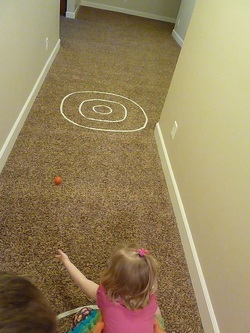 Bringing shuffle-board to the young. There are many ways to play variations of this game. Make a target our of string or painter's tape. You can make the targets big, small, round, square... your imagination is your limit. This game will help kids learn how to aim as well as teaching them how to measure their strength and improve their hand-eye coordination. For smaller kids, use a small beanbag or a simple sock filled with rice (so it doesn't roll). For older kids use a heavy ball. The rolling adds an extra level of required-skill. :) Have fun! thanks whattoexpect.com for the pi  This blog has some amazing ideas of how to play with foam/shaving cream with your little ones. Benefits of foam-playing: sensory skill development with easy clean-up!!! It's great to play with in the tub or outdoors on a hot day. Some of our favorite games from the blog: crackle foam, puffy sand, and clouds in a jar. http://www.growingajeweledrose.com/2013/09/ways-to-play-with-shaving-cream.html 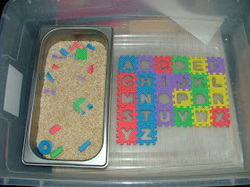 What a fun way to improve fine-motor while working on those sensory skills. "Little Hands, Big Work" has posted this easy game to play with your child at home. Simply fill a bucket or bowl with sand and place the cut-outs of a board game and have your child search for them and then match them to the appropriate piece. For a bathtub variation of this game you can fill a bucket with bubbles and have them paste it to the tile-walls!! 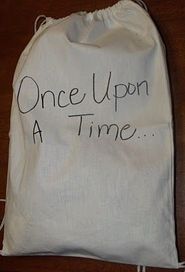 Good communication skills can go a long way. It's important that one fosters a child's communication skills from an early age. In Training Communication Skills in Young Children by: Carolyn Uhlinger Shantz and Karl E. Wilson they discuss the effects of appropriate communications skills in the long term. Some of these effects include healthier relationships, less use of physical violence, lower blood pressure, and advanced career development opportunities. With simple games and family traditions one can encourage their kids to use their verbal communication skills to express themselves. As they say, with practice comes perfection. So, practice this skill all you can!! Building your child's vocabulary as well as teaching them to feel comfortable sharing feelings and opinions will go a long way throughout their lives. Here are some great ideas to bring more communication skill practice into your home: - Aided Story-telling: Use a bag or box filled with objects or words to help aid your child in building a story. (if you use plastic toys you can even play this in the bathtub). Take turns adding to the story with other family members. It's a great way to include siblings of many ages or even grandparents into a game. Be sure to switch up when you find inside the bag, to keep the stories fresh. - "Best, worst and for me": This game is amazing for emotional development as well as building empathy skills. During a chosen time of the day (before going to bed or during dinner-time for example) have your family describe the best moment of their day, the worst part of their day, as well as something someone has done for them. This is a wonderful opportunity to discuss feelings and how to deal with those feelings in healthy manners. Plus, the added "what someone did for me" helps kids to recognize that aiding others is important and it encourages them to do things for others in the long-term. - "Changing the ending": This exercise is great for learning to deal with other's inputs. Have your child tell a story and then re-tell it, changing the ending. They can play this with their friends or siblings too. It's important to encourage participants to be open to the changes others make, which at times can be hard. If you want to push it a step farther you can ask participants to choose a favorite ending at the end of the game or ask them to compliment each other's endings. 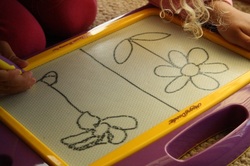 Here is a creative way to work on those fine motor skills, as well as following directions and compliment giving. You can play this on a doodle-board or on a sheet of paper. Draw something on one side and have your child make a duplicate. Then you can switch it around and have them draw first. In the end, practice giving each other positive feedback on your duplicates. This is a great game to play when waiting around at a doctor's office or anywhere that your child may get bored while waiting. For more fun ways to use your doodle-board, check out this blog: http://happyhooligans.ca/magna-doodle-activities/ |
AuthorWe are Recreational Therapists who provide participants with the tools they need to conquer the world using guided play. Archives
December 2014
Categories
All
|

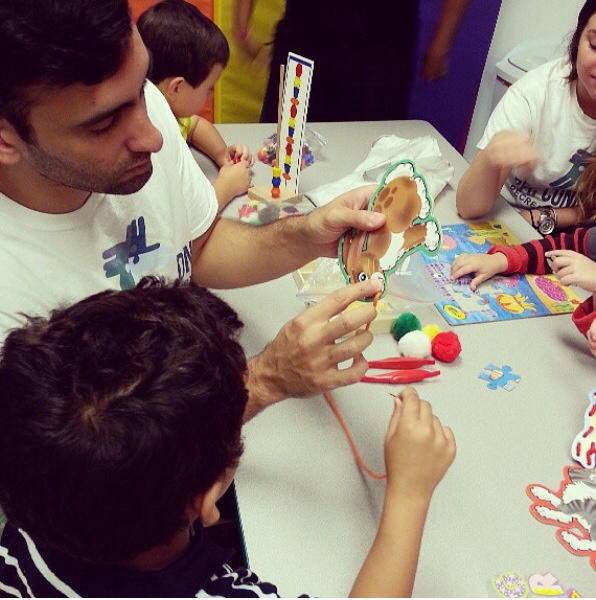
 RSS Feed
RSS Feed
